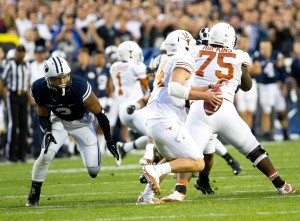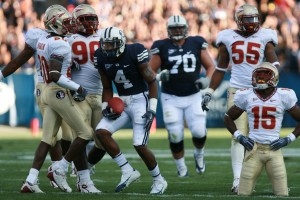Html code here! Replace this with any non empty text and that's it.

It’s been five seasons since BYU football made the radical shift from the Mountain West Conference to what it hoped would be greener pastures as a football independent.
Independence has had advocates and detractors from Day 1, as conference requital has changed the type of opponents BYU has faced, where it plays, and how the games are televised.
The reasons for going Independent were clear: No one could access BYU sports without having the dubious MountainWest Sports Network, a channel all but exclusive to Comcast cable subscribers. The frustrations with coverage were further agitated when long-time rival Utah announced in 2010 it was bolting the conference for a place in the newly formed Pac-12.
After backdoor discussions to remodel and join the WAC turned south, BYU Athletic Director Tom Holmoe made the bold decision to formally sever ties with the Mountain West and declare the Cougars’ independence.
“Being independent increases access to our national following of fans,” Holmoe said at the historic press conference Sept. 1, 2010. “Every home football game and men’s basketball game will now be carried nationally.”
Independence allowed the Cougars to ink a deal with ESPN, a relationship that would make good on Holmoe’s promises of increased exposure. Forty-six of BYU’s 65 games as an independent have been televised by an ESPN affiliate, and all have been televised nationally.
It’s obvious the independent experiment has been a wild success from purely a media coverage standpoint, but how has it affected the quality of Cougar football? Is the program better off now than it was half a decade ago as a member of the Mountain West?
Comparing schedule quality
While it is true that membership in the Mountain West meant home games against UNLV, New Mexico, San Diego State and Wyoming every other year, it also guaranteed Utah, TCU and Air Force. Toss in a couple of home-and-homes with Boston College or UCLA, and Holmoe had hit the football schedule out of the park.
Independence, on the other hand, leads to more boom-or-bust yearly schedules. For every Texas, Ole Miss and Wisconsin, there seems to be a corresponding Idaho, Wagner and Middle Tennessee waiting around the corner.
How BYU’s opponent quality from 2011–2015 as an Independent compares to the opponent quality from 2006–2010 is a question worth asking.
“Power Five-Plus” is a term I created to help measure opponent strength. It isn’t by any means a perfect metric, but it does give us a starting point. Power Five-Plus encompasses all teams who are members of Power Five conferences (ACC, Big 10, Big 12, Pac 12 and SEC) plus Utah and TCU (even in years they were a part of the MWC), as well as Boise State and Utah State.
I consider Boise State on par with teams from Power Five conferences because they’ve finished in the final top-25 rankings seven out of the last 10 years. The same goes for TCU, who finished ranked five out of the six years prior to 2012, the year they officially became part of the Big 12. I also consider BYU’s games against Utah (even before joining the Pac-12 in 2011) and Utah State as “Power Five” matchups due to the rivalry implications.
The main idea behind Power Five-Plus is the ability to identify a season’s “big” games, contests that are compelling regardless of what the incoming records may be. Fans have packed LaVell Edwards Stadium to no less than 99 percent of capacity in 18 of the 22 home games against Power Five-Plus teams since 2006; the only ones that didn’t sell out were ’06 Utah State, ’12 Washington State, ’13 Georgia Tech and ’14 Virginia.
Another term I use is “FCS–Plus,” which is a category that includes both FCS opponents and “non-Power-Five-Plus” teams who are at least 22-point underdogs before kickoff against BYU, according to the historical game line archive of bettorsworld.com. This category accounts for particularly low-quality games that feature vastly overmatched opponents in what turns out to be a competition against the Cougars’ second and third-string units.
It should be noted that the majority of the games BYU plays falls in between the two extremes of Power Five-Plus and FCS-Plus. That’s what makes them spectacularly exciting or dismal.

BYU MWC 2006-2010
- 10 Power Five-Plus home games (8-2 record)
- 28 Power Five-Plus overall (16-12 record)
- 11 FCS-Plus (10 home games)
BYU Independent 2011-2015
- 12 Power Five-Plus home games: 12 (8-4 record)
- 34 Power Five-Plus overall (16-18 record)
- 12 FCS-Plus (11 home games)
BYU Independent 2016-2020
- 15 Power Five-Plus home games scheduled
- 35 Power Five-Plus overall scheduled
BYU has gone 43-22 overall as an Independent, as opposed to 50-15 in their final five years as a member of the Mountain West. Is the decrease in win percentage indicative of facing tougher competition? Perhaps. The Cougars played six more games against Power Five-Plus teams over the past five years than the five proceeding it. Holmoe also managed to bring an additional two more Power-Five Plus opponents to Provo. But the number of FCS-Plus games have also gone up slightly since 2011.
Future schedules
What may be most encouraging is that BYU is currently positioned to continue increasing the number of Power Five-Plus teams faced over the next five years.
As of right now, BYU is scheduled to play 35 Power Five-Plus schools from 2016-2020, and 15 of those will be played in LaVell Edwards Stadium. And those who are coming to Provo aren’t bottom feeders either, and include teams such as UCLA, Mississippi State, Michigan State, Wisconsin, Cal, USC, Washington and Missouri, in addition to games against Utah, Utah State and Boise State mixed throughout.
It may not be as simple as it once was, but if Holmoe can maintain the increased amount of Power Five-Plus scheduling, the Cougars should be set for real growth.
And if it means having to sit through a game against Wagner every so often, that’s a tradeoff I think most Cougar fans are willing to make.
Click here for a BYU football timeline of recent home games played against Power Five-Plus opponents.




